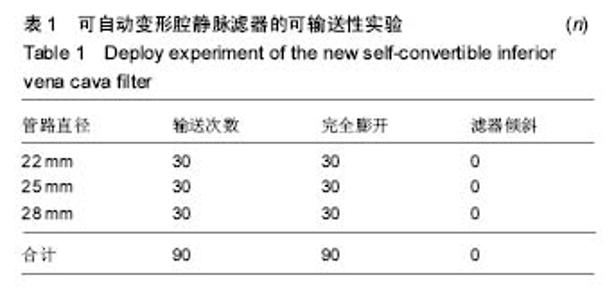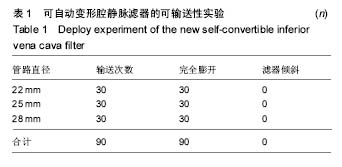| [1]Athanasoulis CA,Kaufman JA,Halpern EF,et al.Inferior vena caval filters: review of a 26 - year single - center clinical experience.Radiology.2000;216(1):54-66.[2]Streiff MB.Vena caval filers: a comprehensive review.Blood. 2000;95(12):3669-3677.[3]Greenfield LJ,Proctor MC.The percutaneous Greenfield filter: outcomes and practice patterns. J Vasc Surg. 2000;32(5): 888-893.[4]Rosenthal D,Wellons ED,Lai KM,et al.Retrievable inferior vena cava filters: initial clinical results. Ann Vasc Surg. 2006;20(1):157-165.[5]William SW.Inferior vena cava filters.Tech Vas Inter Radiol. 2004;7:91-95.[6]Schleich JM,Morla O,Laurent M,et al.Long-term follow-up of percutaneous vena cava filters: a prospective study in 100 consecutive patients.Eur J Vasc Endovasc Surg. 2001;21(5): 450-457.[7]Kinney TB.Update on inferior vena cava filters.J Vasc Interv Radiol.2003;14:425-440.[8]Neurerburg JM,Handt S,Beckert K,et al.Percutaneous retrieval of the Tulip vena cava filter: feasibility, short- and long-term changes—an experimental study in dogs. Cardiovasc Intervent Radiol. 2001;24:418-423.[9]Gregorio de MA, Gimeno MJ,Tobio R,et al.Animal experience in the Günther Tulip retrievable inferior vena cava filter. Cardiovasc Intervent Radiol.2001;24(6):413-417.[10]高喜翔,张建,陈兵,等.ε-己内酯与L-丙交酯共聚物降解性能及其生物相容性[J].中国组织工程研究,2010,14(47):8791-8794.[11]高喜翔,张建,陈兵,等.超声波对高分子材料降解过程启动的控制[J].中国组织工程研究,2014,18(30):4868-4872.[12]Silverstein MD,Heit JA,Mohr DN,et al.Trends in the incidence of deep vein thrombosis and pulmonary embolism: a 25-year population-based study.Arch Intern Med. 1998;158(6): 585-593.[13]Haas S.Venous thromboembolic risk and its prevention in hospitalized medical patients.Semin Thromb Hemost. 2002; 28:577-584.[14]Geerts W,Pineo G,Heit J,et al.Prevention of venous thromboembolism: the Seventh ACCP Conference on Antithrombotic and Thrombolytic Therapy.Chest. 2004; 126(suppl):338S-400S.[15]Buller H,Agnelli G,Hull R,et al.Antithrombotic therapy for venous thromboembolic disease: the Seventh ACCP Conference on Antithrombotic and Thrombolytic Therapy Chest.2004;126(suppl):401S-428S.[16]Gerotziafas G,Samama M.Prophylaxis of venous thromboembolism in medical patients.Curr Opin Pulm Med. 2004;10:356-365.[17]Kearon C.Duration of venous thromboembolism prophylaxis after surgery.Chest.2003;124(suppl):386S-392S.[18]Baillière JB.Phlegmatia alba dolens.In:Trousseau A.Clinique médicale de l'Hôtel-Dieu de Paris. 3rd ed. Vol.3.Paris, 1868: 652-695.[19]Mobin-Uddin K,Smith PE,Martinez LO,et al.A vena caval filter for the prevention of pulmonary embolus. Surg Forum. 1967; 18:209-211.[20]Dorfman GS.Percutaneous inferior vena caval filters. Radiology.1990;174(2):987-992.[21]The PREPIC Study Group.Eight-Year Follow-Up of Patients With Permanent Vena Cava Filters in the Prevention of Pulmonary Embolism: The PREPIC (Prévention du Risque d’Embolie Pulmonaire par Interruption Cave) Randomized Study.Circulation.2005;112:416-422.[22]Kinney TB.Update on inferior vena cava filters.J Vasc Interv Radiol.2003;14:425-440.[23]De Gregorio MA,Gamboa P,Gimeno MJ,et al.The Günther Tulip retrievable filter: prolonged temporary filtration by repositioning within the inferior vena cava.J Vasc Interv Radiol.2003;14(10):1259-1265.[24]Yamagami T,Kato T,Iida S,et al.Günther tulip inferior vena cava filter placement during treatment for deep venous thrombosis of the lower extremity.Cardiovasc Intervent Radiol. 2005;28(4):442-453.[25]Hoff W,Hoey B,Wainwright G,et al.Early experience with retrievable inferior vena cava filters in high-risk trauma patients.J Am Coll Surg.2004;199(6):869-874.[26]Terhaar O,Lyon S,Given M,et al.Extended interval for retrieval of gunther tulip filters. J Vasc Interv Radiol. 2004;15(11): 1257-1262.[27]Greenfield LJ, Proctor MC.Experimental embolic capture by asymmetric Greenfield filters.J Vasc Surg. 1992;16:436-443.[28]Lorch H,Dallmann A,Zwaan M,et al.Efficacy of Permanent and Retrievable Vena Cava Filters: Experimental Studies and Evaluation of a New Device.Cardiovasc Intervent Radiol. 2002;25(3):193-199.[29]Mahnken AH,Pfeffer J,Stanzel S,et al.In Vitro Evaluation of Optionally Retrievable and Permanent IVC Filters.Invest Radiol.2007;42(7):529-535.[30]Simon M,Rabkin DJ,Kleshinski S,et al.Comparative evaluation of clinically available inferior vena cava filters with an in vitro physiologic simulation of the vena cava.Radiology. 1993;189(3):769-774.[31]Hammer FD,Rousseau HP,Joffre FG,et al.In vitro evaluation of vena cava filters.J Vasc Interv Radiol.1994;5(6):869-876.[32]Jaeger HJ,Kolb S,Mair T,et al.In vitro model for the evaluation of inferior vena cava filters: Effect of experimental parameters on thrombus-capturing efficacy of the Vena Tech-LGM filter.J Vasc Interv Radiol.1998;9(2):295-304. |



